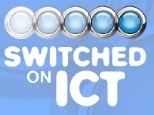
© Copyright Richard Schmidt and licensed for reuse under a CC by 2.0 Licence.
Welcome to staff from New Bradwell, Bradwell Village, The Redway, Gilesbrook, Olney Infants, Heelands, Walnuts, Cold Harbour and Loughton Manor schools, who braved their way through snow this evening to listen to Tina Wright from Slated Row tell us about the Naace ICT Mark.
ICT Mark
The ICT Mark is a great way to recognise whole school improvement and publicly celebrate good practice in the use of digital technology. Having received not only the ICT Mark but also the 3rd Millennium Learning Award, Slated Row is well placed to become our local ICT Mark Champion school. 
As Tina explained, the ICT Mark is an accreditation for schools showing they have reached nationally agreed levels within the Naace self-review framework. The starting place is to complete the self-review framework, considering the impact of your school’s use of ICT and gathering some supporting evidence. Once Naace are happy with your evidence, an ICT Mark assessor visits your school. In Tina’s experience, this was more of a casual tour than a formal inspection, followed by a discussion around a table with 6-8 members of the school community. The idea was to get an impression of the school working as normal and to celebrate putting ICT at the heart of their learning. Slated Row came through with flying colours despite a server crash during their visit. Tina puts much of their success down to their aims of finding real reasons to use ICT for learning and developing genuine ICT capability rather than simply focusing on skills.
The self-review framework costs £50 and the accreditation a further £550 for Primary schools with more than 100 pupils. Tina hopes to continue networking with local schools aiming for their ICT mark. Ann Murtagh, Olney Infants ICT Coordinator and Milton Keynes Early Years Consultant, also offered her support. Contact them here.
ICT Curriculum
One of the self-review framework requirements is a vision for ICT, something that presents a particular challenge in the current climate. We talked about the problems of defining learning objectives in a subject that has the potential to enhance learning in all areas of the curriculum as an ‘embedded’ subject, but also needs to be studied discretely. We agreed that we need to balance the twin goals of learning through ICT and learning to use ICT, and allow children time to become familiar with the tools and software that will become part of their repertoire of skills before they begin to apply them across the curriculum.
We looked at the new Draft Programmes of Study and thought about how terms such as Digital Literacy, Technology Enhanced Learning, Information Technology and Computer Science have been redefined and given a higher profile in the revision of the ICT curriculum to meet changing government objectives. This puts an exciting new emphasis on children as makers and creators through ICT rather than consumers of content.
The following sources of inspiration for curriculum planning were suggested:
Peter Twining’s EdFutures Bliki
Computing at School (CAS) website
Milton Keynes ICT Primary Progression pages
ICT Planning by Ian Addison (Also see his list of Useful Sites)
Simon Haughton’s ICT Curriculum 
Rethinking ICT from Chris Leach
Naace’s ICT Framework
Matt Lovegrove’s Primary ICT Teaching and Learning Framework
We finished our meeting with some ideas sharing around the table. Once again, the collective input led to a useful set of resource links and ideas:
Digital Leaders
Sway Grantham (@swaygrantham) has been developing a Digital Leaders (DL) programme at Bradwell Village School this year. She began by inviting formal applications and selecting children to interview. Over the last term the successful applicants have been trained up through weekly lunchtime sessions. They are now taking on responsibilities such as demonstrating software at staff meetings, solving technical issues, helping with whole-school blogging and computer club, hosting ICT coffee mornings for parents and promoting eSafety within the school. They wear physical badges and earn online badges, and join in with a network of DLs across the country using Edmodo for safe social sharing. We all agreed that this is a fantastic way of promoting ICT within the school and helping the use of technology to run smoothly, with the added benefit of raising individual children’s self-esteem.

Purple Mash
We are all big fans of Purple Mash, even more so since our visit from Katie Hart last term, and Tina shared the news that a substantial discount has been negotiated for Milton Keynes, meaning our schools can get a year’s subscription for just £1 per pupil. Contact Nick Kettle at Milton Keynes Council or Katie Hart at info@2simple.com for more details.
Busy Things
Rachel Cross from The Walnuts showed us the Busy Things website. This colourful UK site has over 240 educational games and activities for EYFS, KS1 and SEN, including phonics  activities based on Letters and Sounds and Jolly Phonics, letter formation, art, music, problem-solving, spelling and numbers. Many are also available as iOS apps. Prices are £20/year for home use or £200 for a school, or you can start with a free trial. The cross-platform versatility means that children can access their favourites from home or you can integrate it into your learning platform. There is also a version of over 80 activities that use icons instead of text and need no written or spoken English, making it accessible for print-challenged or EAL children. Most activities also work with switches. Thanks Rachel, definitely one to investigate!
activities based on Letters and Sounds and Jolly Phonics, letter formation, art, music, problem-solving, spelling and numbers. Many are also available as iOS apps. Prices are £20/year for home use or £200 for a school, or you can start with a free trial. The cross-platform versatility means that children can access their favourites from home or you can integrate it into your learning platform. There is also a version of over 80 activities that use icons instead of text and need no written or spoken English, making it accessible for print-challenged or EAL children. Most activities also work with switches. Thanks Rachel, definitely one to investigate!
Clicker Apps
Helen is excited about the new Clicker Apps for iPads from Cricksoft, though we haven’t been able to try them out yet. These two apps look to be just what we need to support writing on the iPad.


With Clicker Sentences you can quickly set up sequences of sentences for your learners by typing or pasting them in with images from your photo library or camera. You can also get ready-made sentence sets from LearningGrids.com. Children can then listen and tap words in the grid to build sentences, hear each sentence spoken aloud and edit. Sentences can be shown as a model, a pop-up or just spoken aloud as a prompt.
Clicker Docs is aimed at children who can use the onscreen keyboard to type into the simple word processor, then listen to their writing read aloud and correct mistakes. The word predictor suggests and reads aloud words that fit the context of their writing as they compose their sentences. They can also tap to add words from the tabbed word banks that you create to fit a topic or download from LearningGrids.com.
Another recently launched iPad app for assisting challenged writers is iWordQ. You can use this simple text editor for writing with the support of word prediction, text-to-speech, and speech recognition.
Find more tools for supporting writing on Helen’s Pinterest boards.
TeachMeet
We decided to make our next meeting the Milton Keynes TeachMeet on 1st March, organised by Helen, Sway and Emma:

For those who haven’t been before, a Teachmeet is an informal gathering where anyone can share great ideas they’ve trialled in classrooms and join in learning conversations. Everyone is welcome from all types of schools, all subjects, all age groups and all needs. It is a chance for people to hear ideas from each other and be inspired by colleagues. We are pleased to have Drew Buddy (aka Digital Maverick @digitalmaverick) as our Master of Ceremonies hosting a fruit-machine randomised line up of 7-minute presentations and 2-minute nano-presentations. We are also delighted that Peter Ford from NoTosh has agreed to lead an interactive session. This fun evening takes place at the lovely Open University Hub with wifi, live streaming, a twitterfall, free refreshments and a raffle. We guarantee you’ll take away some new contacts and new ideas!
Places are limited to 50 so please sign up here asap.
You can come to watch and listen or think about taking just 2 or 7 minutes to tell us about something you’ve found exciting recently. You’ll find the atmosphere very supportive and we’re sure you’ll be pleased you joined in.
On 9th May we will meet at 4pm at The Walnuts School and Helen will bring a set of 14 iPads to play with. Here’s a map.
Look forward to seeing you soon.

































 in three primary and three secondary schools. Three more schools had their own devices.
in three primary and three secondary schools. Three more schools had their own devices.




 which is well worth a visit, with some fabulous stop frame animations based on the book Handa’s Surprise. Sway also recommends joining over 6000 teachers tweeting live between 8-9pm every Thursday on #
which is well worth a visit, with some fabulous stop frame animations based on the book Handa’s Surprise. Sway also recommends joining over 6000 teachers tweeting live between 8-9pm every Thursday on #

 rds in context, and spoken feedback through text-to-speech. They find their pupils are very keen to use it on their netbooks and note that writing anxieties are reduced by taking away the pressure of needing to be perfect at the first attempt. At the younger end, Margaret from Loughton First is using
rds in context, and spoken feedback through text-to-speech. They find their pupils are very keen to use it on their netbooks and note that writing anxieties are reduced by taking away the pressure of needing to be perfect at the first attempt. At the younger end, Margaret from Loughton First is using 